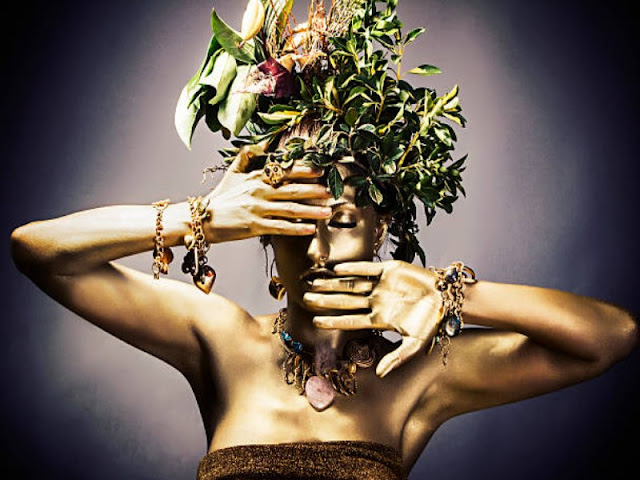Featured
- Get link
- X
- Other Apps
Fashion in Art

A Visual Journey Through History
Art has always been a mirror reflecting the culture, values,
and aesthetics of its time. Fashion, as a form of self-expression, has been an
integral part of this reflection throughout history. From elaborate garments in
Renaissance paintings to minimalist designs in contemporary art, fashion has
been a prominent subject in art. This article delves into the depiction of
fashion in art, exploring famous paintings and sculptures that have celebrated
clothing and style over the centuries.
The Renaissance: Opulence and Elegance
The Renaissance, a period of profound cultural and artistic
transformation in Europe from the 14th to the 17th century, was marked by an
appreciation for beauty and aesthetics. Painters of this era often depicted the
opulence and elegance of the clothing worn by the upper classes. Portraits such
as Hans Holbein the Younger's "Portrait of Henry VIII" and Leonardo
da Vinci's "Mona Lisa" exemplify the intricate details and luxurious
fabrics of the clothing of the time.
One of the most famous paintings of the Renaissance, Sandro
Botticelli's "The Birth of Venus," features the Roman goddess of love
rising from the sea in a flowing, ethereal gown. This painting captures the
grace and fluidity of Renaissance fashion, with the billowing drapery and
intricate patterns on the garments.
The Dutch Golden Age: The Art of Everyday Dress
The Dutch Golden Age, which occurred in the 17th century,
witnessed a shift in art towards the representation of everyday life. Dutch
genre paintings, such as Johannes Vermeer's "Girl with a Pearl
Earring," depicted the clothing of the middle class. These paintings
showcased the simplicity and practicality of everyday dress, often featuring
modest attire and domestic scenes.
Vermeer's masterful use of light and shadow in "Girl
with a Pearl Earring" draws attention to the exquisite details of the
girl's clothing, from the delicate fabric of her turban to the pearl earring
that adorns her ear. This intimate portrayal of clothing highlights the
significance of fashion in the daily lives of people during this era.
18th Century Rococo: Extravagance and Frivolity
The 18th century marked the height of Rococo art, a style
characterized by its extravagance, playfulness, and ornate fashion. Paintings
from this period, such as Jean-Honoré Fragonard's "The Swing,"
exemplify the opulent and extravagant clothing worn by the aristocracy. The
women in these paintings are often adorned with lavish dresses, ornate
hairstyles, and accessories that reflect the excesses of the time.
"The Swing" features a young woman on a swing, her
voluminous pink dress billowing as she swings above a courting couple. The
painting captures the frivolity and extravagance of Rococo fashion, with its
intricate lace, ribbons, and pastel colors.
19th Century Realism: The Portrayal of Social Realities
The 19th century brought about a shift in art towards
realism and a reflection of social realities. The clothing depicted in
paintings from this era often reflected the class and social status of the
subjects. One notable example is Édouard Manet's "Olympia," a
provocative painting that depicts a reclining nude woman with a servant
presenting her with flowers.
"Olympia" showcases the contrast between the stark
nudity of the central figure and the servant's clothing, emphasizing the role
of clothing as a marker of social status. The choice of attire in the painting
plays a significant part in the narrative and social commentary.
The Belle Époque and Art Nouveau: Art as Fashion
The late 19th and early 20th centuries saw the emergence of
the Belle Époque and the Art Nouveau movement. These periods celebrated beauty
and sensuality in both art and fashion. Artists like Alphonse Mucha created
iconic posters and illustrations that blended fashion with art, often featuring
elegant women in flowing, decorative gowns.
Mucha's "La Dame aux Camélias" is a prime example,
with its intricate, flowing fabric and the incorporation of floral motifs,
characteristic of the Art Nouveau style. This fusion of art and fashion was
emblematic of the Belle Époque's fascination with beauty and style.
The Avant-Garde and Modernism: Artistic Experimentation
The early 20th century witnessed the rise of the avant-garde
and modernist movements, which rejected conventional aesthetics and embraced
experimentation. Artists like Pablo Picasso and Georges Braque explored new
ways of representing the human form and its attire. Picasso's "Les
Demoiselles d'Avignon" is a radical departure from traditional depictions
of the female form and clothing.
In this painting, Picasso distorts and deconstructs the
figures, presenting a fractured, abstracted view of the women. Their clothing
is equally unconventional, with angular and disjointed lines. This artistic
experimentation challenged conventional ideas of beauty and fashion.
Contemporary Art and Fashion: From Minimalism to
Conceptualism
In contemporary art, fashion continues to be a source of
inspiration and exploration. Artists like Andy Warhol and Yayoi Kusama have
used fashion as a means of self-expression and a reflection of popular culture.
Warhol's iconic portrait of Marilyn Monroe, for example, incorporates fashion
and celebrity culture.
Yayoi Kusama's avant-garde fashion choices, characterized by polka dots and bold patterns, have become an integral part of her artistic persona. Her immersive art installations often feature visitors wearing polka-dotted clothing, creating a symbiotic relationship between her art and fashion.
Conclusion
Throughout history, the depiction of fashion in art has
evolved alongside changes in societal norms, artistic movements, and cultural
trends. From the opulence of the Renaissance to the avant-garde experimentation
of the 20th century, art has captured the essence of clothing and style in all
its diversity. Fashion in art not only reflects the aesthetics of the time but
also offers a glimpse into the societal values, ideals, and even the rebellions
that have shaped our history. As art and fashion continue to intersect in the
modern era, they remind us of the enduring power of attire as a form of
self-expression and cultural reflection.
- Get link
- X
- Other Apps

